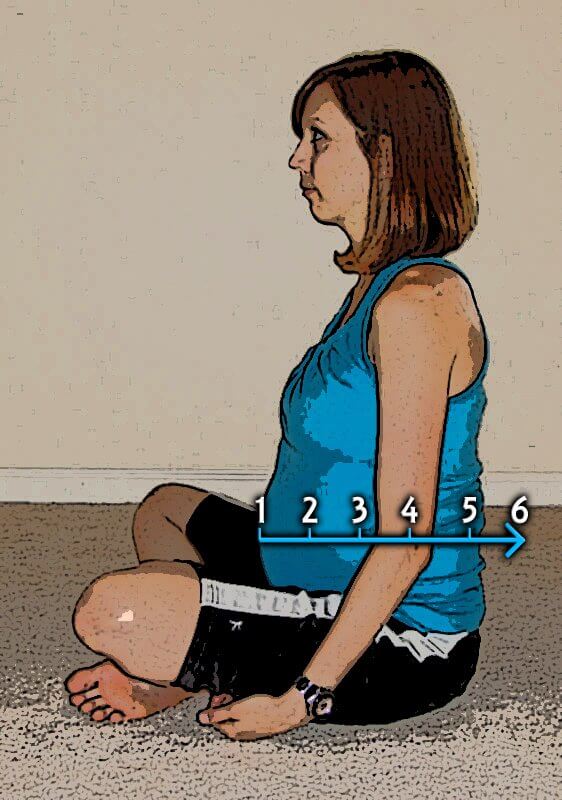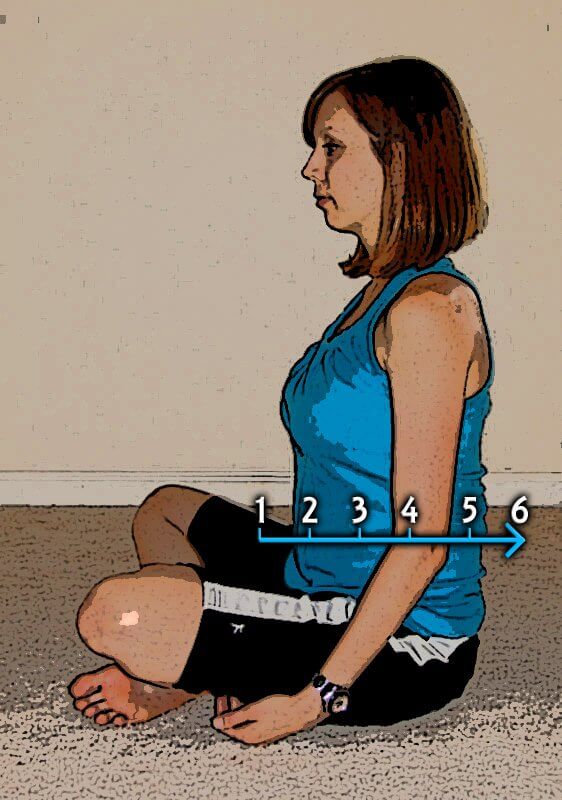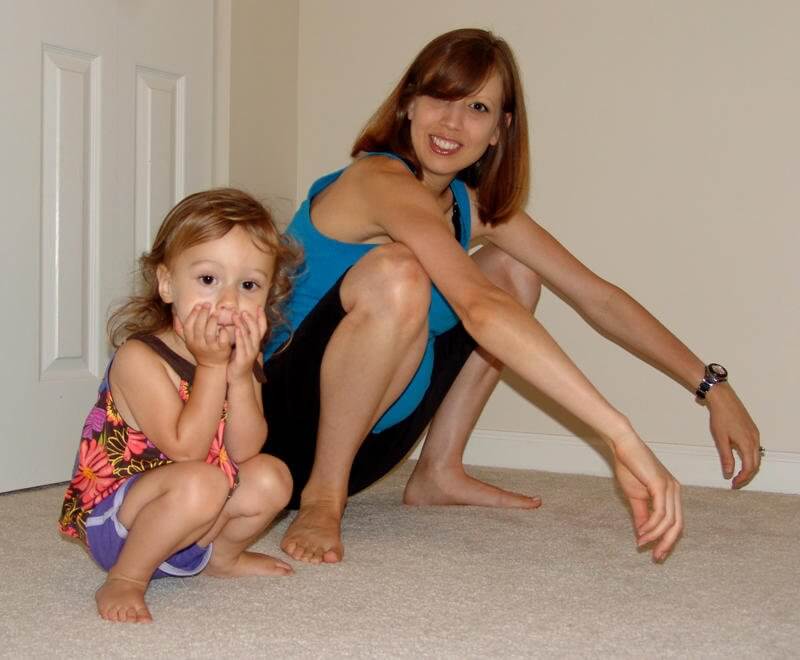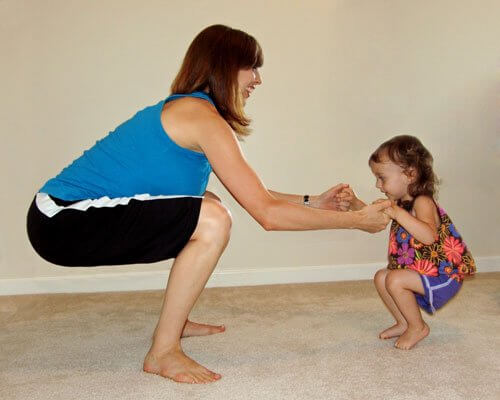Exercises for Pregnancy and Beyond
While many exercises are considered to be safe during pregnancy, some are a lot more beneficial than others. Exercises that are especially important for the expectant mother are those that will help support Mom’s changing body pre- and postpartum and increase strength and flexibility to the muscles needed during labor.
With increased joint laxity during pregnancy, it is more critical than ever to have well-toned, balanced muscles to increase joint stability and decrease pain.
The Transversus Abominis Muscle
Probably the single most important muscle to exercise (pregnant or not), is the transversus abdominis (TA). This muscle acts as the body’s internal corset and is the innermost muscle of the abdominals. During pregnancy, a strong TA becomes even more important to provide support for the back, pelvis, and hips which can decrease pain in those areas, as well as to support the ever-expanding belly.

TA Activation:
Sit cross-legged on the floor with your back against a wall or in a chair with back support
Place your hands on your belly, one above and one below the belly button to make sure all parts of your abdomen are moving backward evenly
Take a belly breath
Inhale through the nose letting the belly expand fully
Exhale through the mouth, letting the belly button sink in, and using your abs, draw the belly button up and in towards your spine
Hold that “belly in” position and breathe [your ribs will now have to expand laterally (out to the sides) while the belly is pulled in (TA contracted)]
Hold for 10 seconds, release
Repeat 10 times
Work up to 30 at a time, 10 second holds each
NOTE: DO NOT let your shoulders round during this exercise. Keep them down and back against the wall. Once you master this exercise against a wall, try it without the back support and later seated on an exercise ball for increased difficulty.

TA Challenge (Tupler Technique):
Picture a sideways elevator with five floors from front to back (belly to spine) with a sixth floor behind your back
Begin in the same position as the previous exercise
Inhale and expand the belly fully
Exhale and pull in the belly as far back as you can
While breathing (and counting), begin doing tiny backward abdominal pulses as if you’re pulling your belly button out the back of your body (as if trying to reach sixth floor)
Keep the pulses small
DO NOT release the belly completely between each pulse
Picture your belly button pulsing from just inside your back to just outside your back (from fifth to sixth floor)
Do 10-20 pulses. Work up to 100 pulses at a time.
Count out loud to make sure you are breathing
NOTE: If done correctly, you will feel this in your back.
Purpose: Support the low back, hips, and pelvis to decrease or prevent pain, and to prepare to push the baby out during labor.
Tip: The TA is a crucial “pushing” muscle during labor. Practice the pushing technique while sitting on the toilet by exhaling with mouth open, pulling the belly in, and bearing down (while still exhaling). Relax the pelvic floor muscles completely. DO NOT HOLD YOUR BREATH! It also helps to have your feet up on a low (6-8”) stool.
The Pelvic Floor
The pelvic floor is a group of muscles surrounding the urethral, vaginal, and rectal openings. This is obviously an area that will be stretched to its limits during the birthing process. It is important to have strong yet flexible pelvic floor muscles so they can stretch and rebound as needed during labor without tearing or episiotomy.
Kegel exercises are a good way to strengthen these muscles. You are probably familiar with Kegels….squeeze the pelvic floor muscles as if stopping a flow of urine AND trying to keep from passing gas. You should be able to differentiate between squeezing from the back, middle, and front. There are several variations to Kegels that will increase strength and endurance as well as overall muscle control of the area.
Pelvic Floor Elevators:
Begin in a comfortable position, seated (more difficult) or lying down (easier)
Pull in the pelvic floor slowly, as if slowly curling your fingers to make a fist
Continue to squeeze, pulling up into the body like an elevator going up one floor at a time
Imagine the elevator has two floors
Pull up to the first floor, HOLD
Continue up to the second floor, HOLD
Slowly release, one floor at a time (stopping again at the first floor)
Completely release to ground floor
Make sure the pelvic floor is completely open and relaxed at ground floor before repeating
Repeat 10 times, working up to 3 sets of 10 (or more) at a time
To increase the challenge, picture three floors instead of two
NOTE: This should be a very controlled, deliberate movement. Try not to squeeze your gluteal (bottom) muscles. Concentrate on isolating the pelvic floor. Lying down may make this easier.
Variation: Instead of a slow contraction (slowly squeezing fist), do fast pelvic muscle squeezes or pulses. These should be hard and fast contractions. Work up to doing 100 pulses at a time. Make sure to fully relax after the reps.
Purpose: To build pelvic floor strength, flexibility, and control to increase birthing efficiency as well as to decrease perineal tearing or episiotomy during labor.

Squatting
The final exercise that I feel should be an absolute priority in preparation for birth is squatting at rest. Unfortunately, our society all too often is sedentary, and we sit down… a lot. Sitting is the most stressful resting position for the discs in our backs. It can also lead to decreased overall muscle tone and poor posture. Squatting is an alternate resting position that will not compromise posture, muscle tone, or spinal health.
Squat at rest:
Carefully lower yourself into a deep squat OR begin from a kneeling position and then bring one foot at a time onto the floor
If needed, hold onto a support (or partner) in front of you or have your back up against a wall for balance
Ideally, your bottom should be resting on the backs of your legs, knees spread apart and turned outward, feet flat on the floor
Hold this position for 30 seconds, working up to 5 minute holds at a time
Practice squatting throughout the day, whenever you would normally sit down and, of course, ALWAYS squat to pick something up

Squat lift challenge:
Either hold onto a stable object or a partner in front of you
From the resting squat position, carefully raise your bottom off of your legs until your knees and hips are at a 90˚ angle as if sitting in a chair
You should be able to see your toes in front of your knees (if your belly isn’t in the way already)
Knees should be directly over your ankles and turned outward
Thighs are parallel to the floor
Practice in front of a mirror, if needed, to make sure you’re aligned correctly
The lift will result in a very small movement into a very low squat
Slowly return to resting squat position
Repeat 5 times
NOTE: Do not attempt this challenge exercise if it is painful or if you have a history of knee or hip problems.
Purpose: Increase ankle, knee, hip, low back, and pelvic floor mobility, stability, and endurance while increasing balance. Squatting is an excellent position during labor as the pelvis is able to fully open and allow gravity to help move the baby through the birth canal. The challenge exercise will elicit an automatic pelvic floor contraction with each lift, thus strengthening these muscles more effectively than Kegels.
Condition those muscles!
While there are many more exercises that can be beneficial during pregnancy, these key muscles are the ones I would highly recommend focusing on as a bare minimum. Try to perform each exercise at least two times per day. Feel free to do more…you can’t do these exercises too often! Well-conditioned muscles can aid in a more comfortable pregnancy, efficient delivery, and speedier postpartum recovery.
NOTE: The exercises described are for an assumed low-risk pregnancy. Please consult with and gain clearance from your healthcare practitioner before beginning this or any new exercise program.
Looking for another workout option during pregnancy, or a way to get back into shape after baby has arrived? Fit2B Studio offers a workout program that is safe for pregnant mothers as well as post-partum mothers wanting to get back into shape. If you’d like gentle, guided exercises to round out your birth preparation and recovery, this is a great resource!
What type of exercises do you do to keep yourself in-shape during pregnancy and prepared for labor and birth?







I love the pictures of your daughter as your support partner! So precious!
.-= Ambre´s last blog ..Pizza with a Grain Free Twist =-.
Ha! Thanks Ambre! She was having fun “helping Mama.” Not really ideal for the squat raise though since I outweigh her by a bit. 🙂
.-= Angela´s last blog ..Pregnancy Exercises =-.
Great article! I just had a baby and need to start thinking about exercises to re-tone my tummy muscles. 🙂
Brooke, definitely hit those Transverse abs! That will trim down inches on the waist and pull things back together faster. Congrats on the new baby!! I’m not far behind you…
Angela, what can you recommend for postpartum healing of diastasis recti?
Thanks,
Tammy
@Tammy L,
Hi Tammy,
Diastasis can be healed/brought back together by hitting the TA exercises and avoiding all types of sit-ups, crunches, etc….even sitting straight up when getting out of bed can further split a diastasis.
Julie Tupler has a technique specifically for diastasis prevention and repair. I like her “Maternal Fitness” book and haven’t checked out the “Lose Your Mummy Tummy” DVD/book but that would be the one you need for after baby. I have a couple of her exercises described on my blog and she also has a website (diastasisrehab[dot]com).
Let me know if you have further questions and I’d be happy to help!
Yay for a perfectly timed post. I’m 14 weeks with baby #3, and I am certainly feeling those muscles are a lot looser than before and could use some help. Love the squatting – makes so much sense, and chasing around two toddlers makes it easy to do whenever.
these are great ideas. I squatted a lot with my most recent pregnancy. I’ll have to keep these in mind for when I am hopefully pregnant again sometime.
Just wanted to let you know you’re appreciated. Your advice is extremely useful to me. Thank you!
Wow thanks so much for these! This is exactly what I need. I’m 30 weeks pregnant and have a 2 year old and my lower back has been killing me – I can’t hardly do anything around the house without getting it going (and I’ve just started nesting!). I know it’s from weak muscles and lack of muscular support. I will start doing these, I’m SURE they are going to bring great relief.
@Andrea, I’m so glad they’re helpful for you, Andrea! Blessings on you and your new baby! 🙂